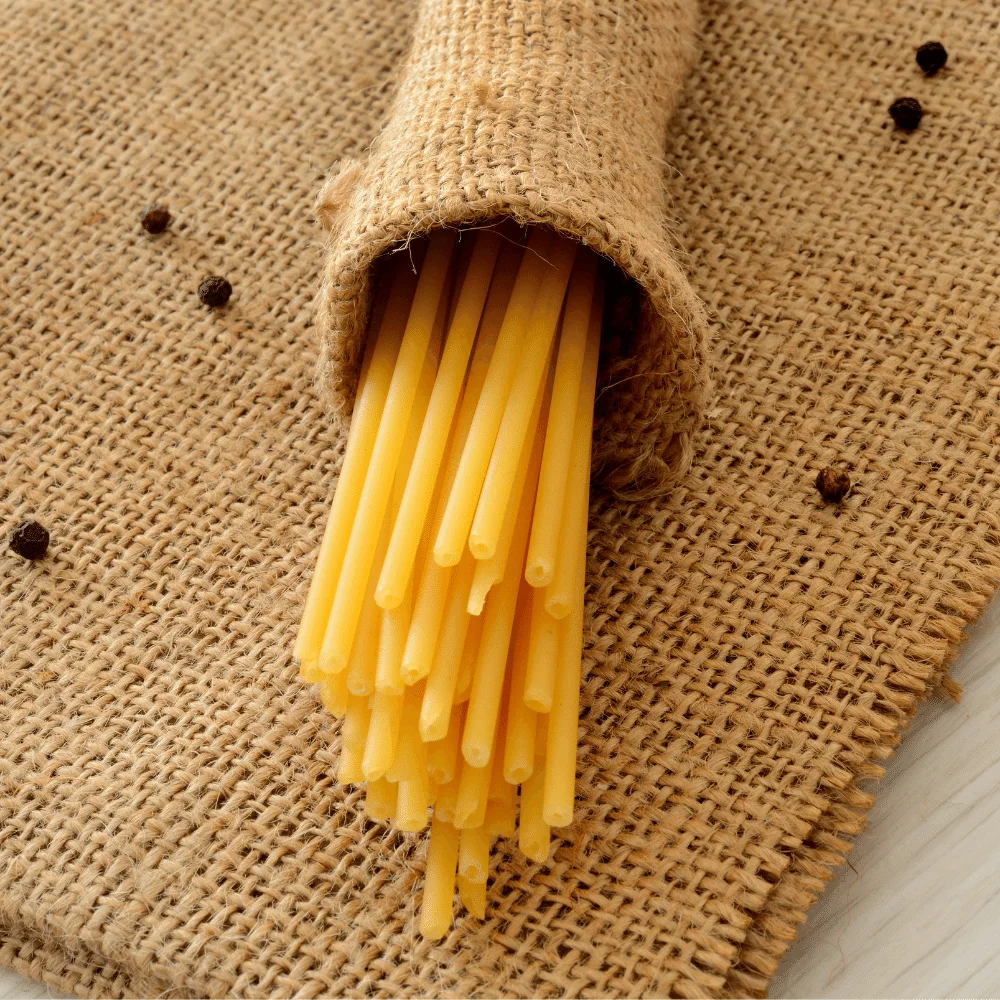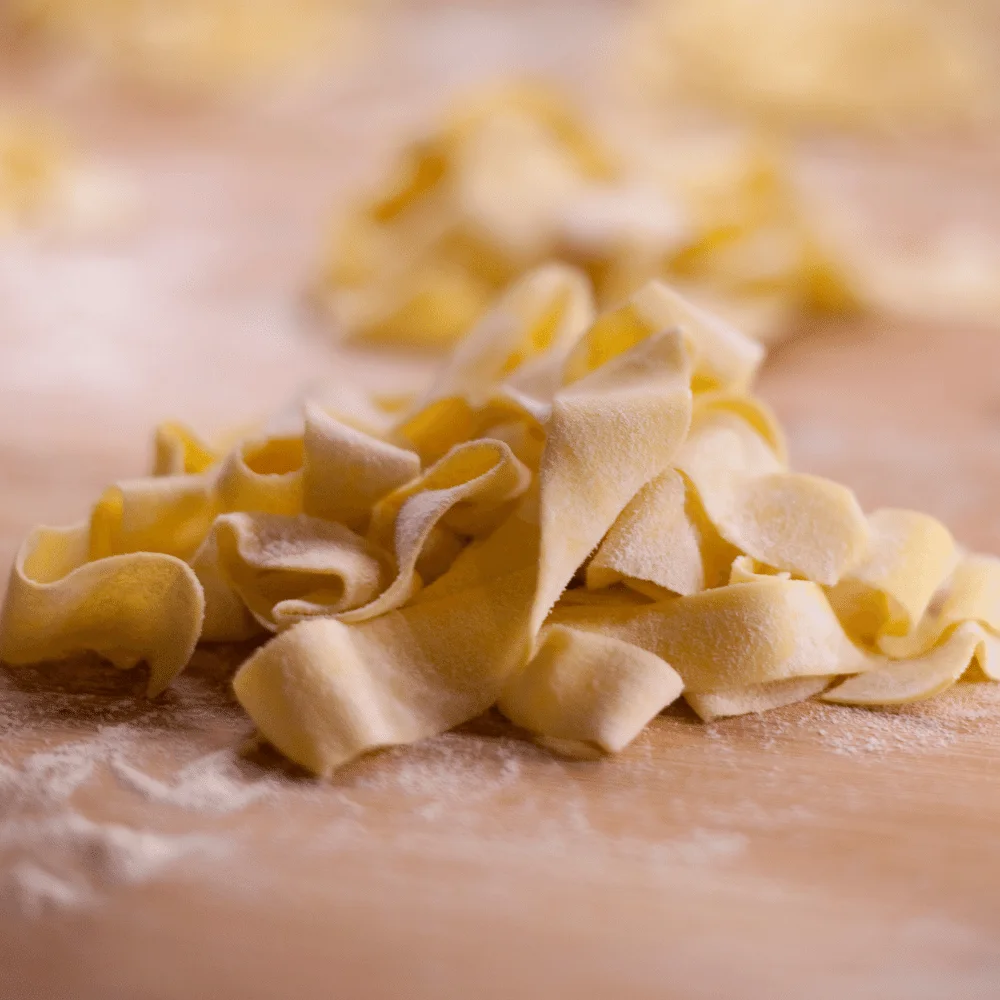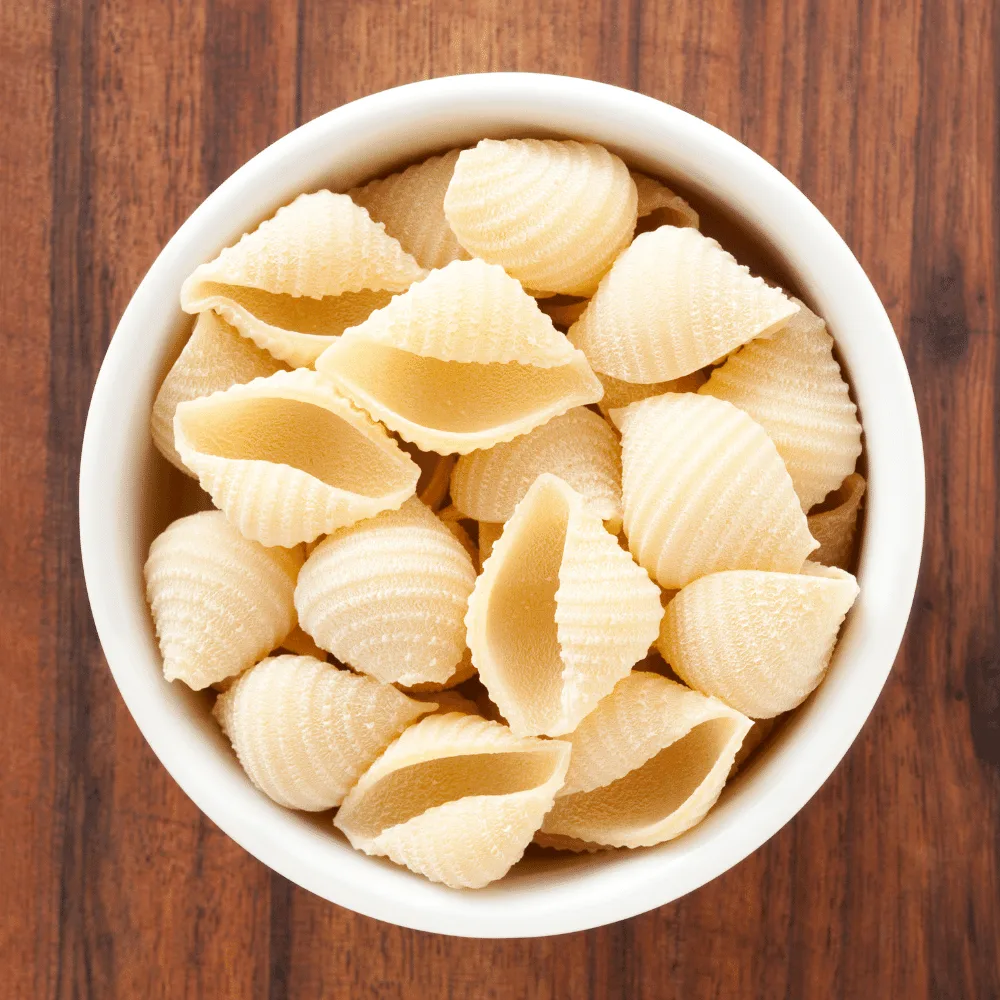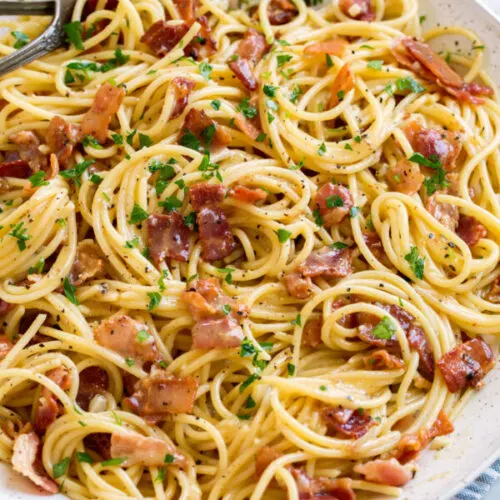Are you a pasta lover?
If so, then carbonara is probably one of your favorite dishes.
Carbonara is an Italian dish that combines eggs, cheese, and bacon in a creamy sauce.
It’s incredibly flavorful and comforting – the perfect combination for any meal.
But to make the perfect carbonara, you need the right kind of pasta!
After all, not all pastas are created equal when it comes to this classic dish.
That’s why I’ve put together a list of 13 best pastas for carbonara – so that you can get the most out of your next plate!
Read Also: What Wine Goes With Spaghetti Carbonara? (10 Best Wines)
What is Carbonara?

Carbonara is an Italian pasta dish made with eggs, cheese, bacon or pancetta, and black pepper.
It’s a simple yet flavorful dish that can be served as a main course or side dish.
The traditional version of carbonara uses spaghetti noodles but other types of pasta such as fettuccine or penne can also be used.
- To make carbonara, the bacon or pancetta is cooked in a pan until it’s crispy and then set aside.
- Meanwhile, the pasta is cooked according to package instructions and drained.
- In a separate bowl, whisk together eggs and grated Parmesan cheese until combined.
- Once the pasta has been drained, add it back to the pot along with the egg mixture and stir everything together over low heat until creamy (this should only take about 1-2 minutes).
- Finally, add in the bacon/pancetta pieces and freshly ground black pepper to taste before serving immediately.
Carbonara is best enjoyed while still hot so that all of its flavors are at their peak!
13 Best Pasta For Carbonara
There are many different types of pasta that can be used to make a delicious Carbonara.
Here are thirteen of the best pastas to use in the dish:
1. Bucatini

Bucatini is a type of pasta that is long and thick, with a hole running through the center.
It looks like spaghetti but it’s hollow in the middle.
The name comes from the Italian word buco, which means “hole”.
Bucatini has a chewy texture and holds sauce well, making it perfect for dishes like carbonara or amatriciana.
Its hollow shape also makes it great for soups and stews because it can absorb more liquid than regular spaghetti noodles.
Pro Tip: To get the most out of your Bucatini, cook them al dente (firm to the bite).
This will help them hold their shape better when mixed with sauces or other ingredients.
2. Fettuccine

Fettuccine is a type of pasta that originated in Italy. It is made from egg and flour, and has a flat, ribbon-like shape.
Fettuccine is often served with rich sauces such as Alfredo or Carbonara.
Fettuccine has a slightly chewy texture that stands up well to heavier sauces like carbonara.
The wide noodles also make it easier to twirl the pasta around your fork for an enjoyable eating experience!
Fun Fact: Fettuccine was named after its resemblance to the Italian word for ‘ribbon’, fettucce!
3. Spaghetti

Spaghetti is a type of pasta that is long, thin and cylindrical in shape.
It is made from durum wheat semolina flour and water, and it can be served with a variety of sauces or toppings.
Spaghetti has become one of the most popular types of pasta around the world, thanks to its versatility and delicious flavor.
Spaghetti pairs perfectly with Carbonara sauce, which consists of eggs, cheese, bacon (or pancetta), black pepper and olive oil.
The combination creates a creamy sauce that coats each strand of spaghetti for an indulgent dish.
Fun Fact: Spaghetti was invented in Italy in the 13th century! It wasn’t until the 19th century that it became popular outside Italy – now it’s enjoyed all over the world!
4. Rigatoni

Rigatoni is a type of pasta that originated in Italy.
It is a large, tube-shaped noodle with ridges along the sides and ends.
The name comes from the Italian word “rigato,” which means “ridged.”
Rigatoni can be used in many dishes, including baked casseroles, soups, and salads.
Rigatoni is an excellent choice for Carbonara because its shape helps to hold onto the sauce better than other types of pasta.
Its ridges also help to create more surface area for the sauce to cling to, resulting in a richer flavor experience with every bite!
Fun Fact: Rigatoni was originally created as a way to use up leftover pieces of dough from making other types of pasta!
5. Penne

Penne is a type of pasta that is shaped like a tube with ridges on the outside.
It’s usually made from durum wheat and comes in different sizes, including short penne, long penne, and even jumbo penne.
Penne is one of the most popular types of pasta for making dishes like carbonara because it holds sauces well and has an interesting texture.
Penne pairs particularly well with creamy sauces like carbonara because its ridges help to hold onto the sauce better than other types of pasta.
The ridges also give it an interesting texture that makes it more enjoyable to eat than plain spaghetti or linguine.
Fun Fact: Penne was invented in 1865 by a baker named Giovanni Battista Capurro who wanted to create a unique shape for his macaroni!
6. Farfalle

Farfalle, also known as bow-tie pasta, is a type of Italian pasta shaped like small bows or butterflies.
It is made from durum wheat flour and water.
Farfalle can be used in a variety of dishes, including soups, salads, casseroles, and baked dishes.
Farfalle has a slightly chewy texture that holds up well to sauces like carbonara.
The ridges on the surface of the pasta help to hold onto the sauce for maximum flavor in every bite!
Fun Fact: Farfalle was named after its resemblance to butterfly wings!
7. Orecchiette

Orecchiette is a type of pasta that originated in the region of Apulia, Italy.
It is shaped like small ears and has a slightly chewy texture.
Orecchiette can be served with any number of sauces, but it pairs particularly well with creamy sauces such as carbonara.
Orecchiette’s shape helps to hold onto the sauce better than other types of pasta, making it an ideal choice for dishes like Carbonara.
The ridges on the surface also help to trap bits of bacon or cheese, creating a more flavorful dish.
Fun Fact: Orecchiette translates to ‘little ears’ in Italian!
8. Tagliatelle

Tagliatelle is a type of pasta that originated in the Emilia-Romagna region of Italy.
It is made with egg and flour, and has a flat, ribbon-like shape.
Tagliatelle is often served with rich sauces like Carbonara or Bolognese.
Tagliatelle has a slightly chewy texture and can hold up to heavier sauces better than other pastas like spaghetti or linguine.
The wide ribbons also make it easier to twirl around your fork for an elegant presentation!
Fun Fact: Tagliatelle was named after the Italian word “tagliare” which means “to cut” because it was traditionally cut by hand into long strips!
9. Linguine

Linguine is a type of pasta that resembles long, flat strands.
It is wider than spaghetti but not as wide as fettuccine.
Linguine originated in Genoa and the surrounding Liguria region of Italy, and it has become popular around the world.
Linguine pairs well with light sauces like pesto or carbonara because its shape allows it to hold onto sauce better than other types of pasta.
The thin strands also cook quickly, making them ideal for weeknight meals when you don’t have much time to prepare dinner.
Fun Fact: Did you know that linguine means ‘little tongues’ in Italian?
This name comes from the shape of the pasta which looks like little tongues!
10. Pappardelle

Pappardelle is a type of pasta that originated in Italy.
It is made from egg and flour, and has a wide, flat shape.
The name comes from the Italian verb ‘pappare’, which means ‘to gobble up’.
Pappardelle is perfect for Carbonara because its wide shape allows it to hold more sauce than other types of pasta.
Its texture also helps to create a creamy sauce when combined with eggs and cheese.
Pappardelle can also be used in soups or served with tomato-based sauces.
Fun Fact: Pappardelle was traditionally served on special occasions such as weddings or religious holidays!
11. Lasagna Noodles

Lasagna noodles are a type of pasta that is traditionally used in Italian lasagna dishes.
They are wide, flat sheets of pasta that can be layered with other ingredients to create a delicious dish.
Lasagna noodles come in various shapes and sizes, from the classic long strips to more modern shapes like squares or circles.
Lasagna noodles can be used as an alternative to traditional spaghetti for carbonara dishes.
The wider surface area allows for more sauce and cheese to cling onto the noodle, making it even richer and creamier than regular spaghetti carbonara!
Fun Fact: Lasagna noodles were first created in Naples, Italy during the 16th century!
12. Cavatappi

Cavatappi is a type of pasta that is shaped like a corkscrew.
It has ridges on the outside and a hollow center, making it perfect for holding sauces.
Cavatappi is often used in dishes such as macaroni and cheese, casseroles, soups, salads, and more.
Carbonara with cavatappi is an Italian classic dish made with egg yolks, Parmesan cheese, bacon or pancetta (or both!), garlic and black pepper.
The creamy sauce clings to the ridges of the cavatappi noodles perfectly creating an indulgent yet simple dish that’s sure to please everyone at the table!
13. Conchiglie

Conchiglie, also known as shell pasta, is a type of pasta shaped like shells.
It is usually sold in the form of large and small shells, which are perfect for holding sauces and other ingredients.
The shape makes it ideal for dishes like carbonara or macaroni and cheese.
Conchiglie has a slightly chewy texture that stands up well to creamy sauces.
Its ridges help to hold onto the sauce better than other types of pasta, making it an excellent choice for dishes like carbonara.
Fun Fact: Conchiglie was originally created by Italian artisans in the 16th century using molds made from seashells!
FAQ
What type of pasta is used in carbonara?
The most popular type of pasta used in carbonara is spaghetti or rigatoni.
Spaghetti is the classic choice, as its long strands are perfect for twirling around your fork and capturing the creamy sauce. Rigatoni is also a great option, as its tube-like shape holds the sauce well.
Ultimately, it comes down to personal preference.
If you’d like to try something different, other pasta shapes like penne, fettuccine, or bucatini can also be used. Whichever you choose, you’re sure to have a delicious carbonara dish!
What is traditional carbonara made of?
Traditional Spaghetti Carbonara is a classic Italian dish that is made with just five simple ingredients: spaghetti, guanciale (cured pork cheek), black pepper, pecorino Romano (sheep’s milk cheese), and eggs.
The guanciale is browned in a pan to give the dish its distinctive flavor, while the eggs are beaten and added to the hot pasta to create a creamy sauce. The pecorino Romano adds a salty, sharp flavor to the dish, and the black pepper adds a hint of spice.
All of these ingredients combine to create a delicious and comforting meal that is sure to please.
What is the golden rule of cooking a carbonara?
The golden rule of cooking a Carbonara is to choose the right pasta and cook it al dente. This means that the pasta should be cooked until it is firm to the bite, as overcooking it will result in a mushy texture that won’t hold up to the creamy sauce.
Additionally, it’s important to choose the right type of pasta for Carbonara. Long, thin strands like spaghetti or linguine are the best choice, as they will hold the sauce better than short, thick shapes like penne or rigatoni.
Following these steps will ensure that your Carbonara is cooked to perfection.
What cheese can I use instead of Parmesan for carbonara?
Pecorino Romano is a great substitute for Parmesan cheese in carbonara.
It has a similar base flavor and texture to Parmesan, but it is made from sheep’s milk, which has a higher fat content than cow’s milk.
This gives Pecorino a slightly saltier and sharper flavor than Parmesan, which can add a nice depth of flavor to carbonara.
Additionally, Pecorino is a hard cheese, so it will still provide the same texture as Parmesan when grated.
Conclusion
In conclusion, carbonara is a classic Italian dish that is best served with the right type of pasta.
There are many different types of pasta that can be used for carbonara, but the best types are bucatini, fettuccine, spaghetti, rigatoni, penne, farfalle, orecchiette, tagliatelle, linguine, pappardelle, lasagna noodles, cavatappi, and conchiglie.
Each of these types of pasta has its own unique texture and flavor that can enhance the taste of your carbonara.
So, the next time you’re making carbonara, reach for one of these types of pasta and enjoy the delicious results.
Related:
What Meat Goes Well with Carbonara? (10 Kinds of Meat)
What to Do with Leftover Carbonara Sauce (14 Ideas)

13 Best Pasta For Carbonara
Ingredients
- Bucatini
- Fettuccine
- Spaghetti
- Rigatoni
- Penne
- Farfalle
- Orecchiette
- Tagliatelle
- Linguine
- Pappardelle
- Lasagna Noodles
- Cavatappi
- Conchiglie
Instructions
- Pick your favorite pasta from the list above.
- Follow the cooking directions for your selected pasta with the proper ratio of ingredients.
Jenny has always been passionate about cooking, and she uses her platform to share her joy of food with others. Her recipes are easy to follow, and she loves giving tips and tricks to help others create their own unique culinary creations.

